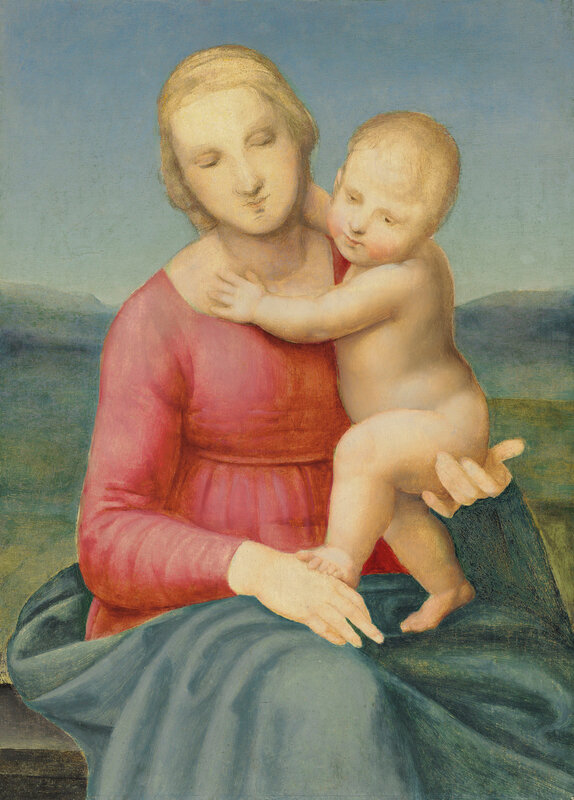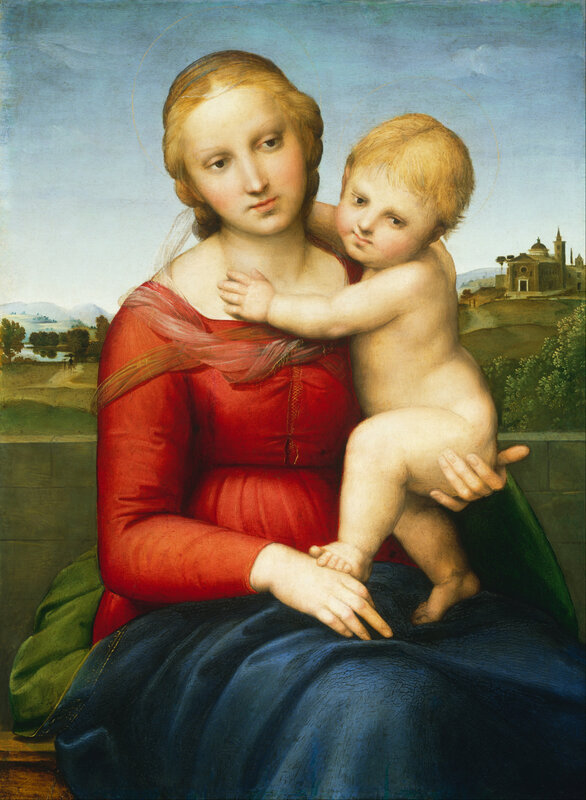Attributed to Raffaello Sanzio, called Raphael or a close associate, "The Peruzzi Madonna": The Madonna and Child

Lot 7. Attributed to Raffaello Sanzio, called Raphael (Urbino 1483-1520 Rome) or a close associate, "The Peruzzi Madonna": The Madonna and Child, oil on panel, 23 ¾ x 17 3/8 in. (60.3 x 44.1 cm.). Estimate USD 400,000 - USD 600,000. Price realised USD 552,500. © Christie's Images Ltd 2018
Provenance: (Possibly) Lucrezia d’Este (1535-1598), Duchess of Urbino.
(Possibly) Peruzzi collection, Florence.
(Possibly) Lombardi collection, Florence.
Frank G. Macomber, Boston, and by inheritance in 1929 to
Mrs. F.G. Macomber, Boston; Parke-Bernet, New York, 2 March, 1950, lot 29, where acquired by
Gordon Graves, New York, 1950-1962.
Acquired in 1962, by the grandfather of the present owner.
Literature: J. Passavant, Raphael d'Urbin et son pe're Giovanni Santi, 1860, II, p. 26, as Raphael.
(Possibly) J.A. Crowe and G.B. Cavalcaselle, Raphael: his life and works, London, I, p. 251, note, as a copy in the Lombardi collection, Florence.
Pittsburgh Post-Gazette, 28 November 1931, p. 11.
G.M. Richter, "The Peruzzi Madonna", Burlington Magazine, LXVII, 1935, pp. 202-211, pls. I and II, as Raphael.
F.E. Washburn Freund, Le Stanze di Raffaello, New York, 1936, p. 52, as Raphael.
O. Fischel, Raphael, Ed. by B. Rackham, London, 1948, I, p. 358, as a replica.
E. Camesasca, Tutta la pittura di Raffaello, Milan, 1956, I, p. 84.
L. Dussler, Raphael. A Critical Catalogue of his Pictures, Wall-Paintings and Tapestries, trans. by S. Cruft, London and New York, 1971, p. 19, as a copy, with early provenance as Lombardi collection, Florence.
J. Meyer zur Capellen, Raphael. A Critical Catalogue of His Paintings, Landschut, I, p. 206, no. 23/II.1, as a copy.
C.C. Bambach, “The Cartoon for La Belle Jardinière, Replicas, and Practices of Full-Scale Design in Raphael’s Florentine Madonnas”, in Raffael als Zeichner / Raphael as Draughtsman, Frankfurt, 2015, pp. 69-74, 80-81, note 47, figs. 11, 14, 16, as "Umbrian artist near Raphael (Domenico Alfani?), with emendations by Raphael".
Exhibited: New York, P. Jackson Higgs, Special exhibition of the lost "Peruzzi Madonna" by Raphael, for the benefit of the Emergency Employment Relief Committee for the Unemployed of New York City, 12-14 November 1931.
Note: This fascinating painting is a second version of Raphael’s celebrated Small Cowper Madonna (National Gallery of Art, Washington D.C..). Known as The Peruzzi Madonna since it was first published in the 19th century, the present work is unfinished. The preparatory underdrawing, which is present throughout and in many places is visible to the naked eye, reveals a confidence of draftsmanship and refinement of technique that has led a number of scholars to endorse the attribution to Raphael himself. The panel depicts the Virgin seated on a stone ledge, embraced by the Christ Child, who stands on her lap with his foot resting on her right hand. Behind them, the artist began a verdant landscape set beneath a bright blue sky; only the basic details of the vista have been blocked out. Certain passages of the panel are worked up to a higher degree of finish than others, and it is in these areas – particularly the Christ Child’s torso - that we witness the kind of subtle brushwork and graceful variation of tone that one might expect from the hand of Raphael himself.
The Peruzzi Madonna is identical in scale and overall design to Raphael’s Small Cowper Madonna (fig. 1), one of the artist’s most celebrated works from the years he was in Florence (1504-08). There are several, notable compositional changes, however. Whereas in the Washington panel, the Madonna and Child gaze directly at the viewer, in the Peruzzi MadonnaChrist looks downward and his mother’s eyelids are nearly closed. The Virgin’s face here is also more oval than in the Small Cowper Madonna.This physiognomy, along with the Madonna’s inclined head, tilted slightly to her right, is much closer to Raphael’s nearly contemporary Madonna del Granduca (Palazzo Pitti, Florence). In particular, both Virgins share the same narrow nose, full lips accented with a slight smile, and gracefully-sloping jawline. The drapery and landscape of the Peruzzi Madonna also display differences relative to the Small Cowper Madonna, although it is difficult to say whether these are due to the former’s unfinished state. Most conspicuously absent in the Peruzzi Madonna is the background architecture, which in the Washington panel is generally believed to have been inspired by the church of San Bernardino outside Urbino. Both paintings are strongly influenced by the innovations of Fra Bartolomeo and Leonardo da Vinci, the latter of whose Mona Lisa (Musée du Louvre, Paris) was presumably the direct source for the Madonna’s elongated right hand. Yet as with all of Raphael’s designs, he is never a mere copyist. Though Leonardo’s composition may have served as an inspirational starting point, Raphael always reinterprets his sources to create something altogether new.

Raphael (Marchigian, 1483 - 1520), The Small Cowper Madonna, c. 1505, oil on panel, 59.5 x 44 cm (23 7/16 x 17 5/16 in.), Widener Collection, 1942.9.57 © 2018 National Gallery of Art.
Christie's. Old Masters, New York, 30 October 2018

/https%3A%2F%2Fprofilepics.canalblog.com%2Fprofilepics%2F1%2F0%2F100183.jpg)
/https%3A%2F%2Fstorage.canalblog.com%2F03%2F02%2F119589%2F96711876_o.jpg)
/https%3A%2F%2Fstorage.canalblog.com%2F11%2F31%2F119589%2F94773502_o.jpg)
/https%3A%2F%2Fstorage.canalblog.com%2F20%2F83%2F119589%2F94772815_o.jpg)
/https%3A%2F%2Fstorage.canalblog.com%2F26%2F72%2F119589%2F75604929_o.jpg)
/https%3A%2F%2Fstorage.canalblog.com%2F59%2F60%2F119589%2F26458628_o.jpg)


/image%2F1371349%2F20240417%2Fob_9708e8_telechargement.jpg)
/image%2F1371349%2F20240417%2Fob_91ce89_x5173-online-caravaggio-the-martyrdom.jpg)
/image%2F1371349%2F20240417%2Fob_d3a4e9_437713486-1653094185460594-71860440393.jpg)
/image%2F1371349%2F20240417%2Fob_961e87_437772831-1653147868788559-54808306367.jpg)